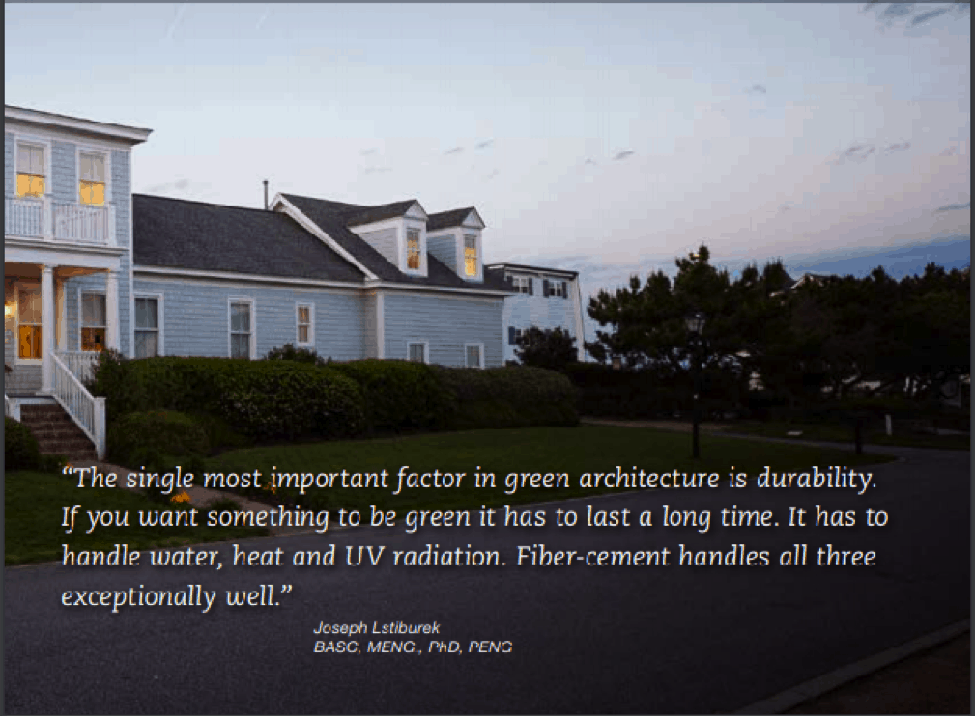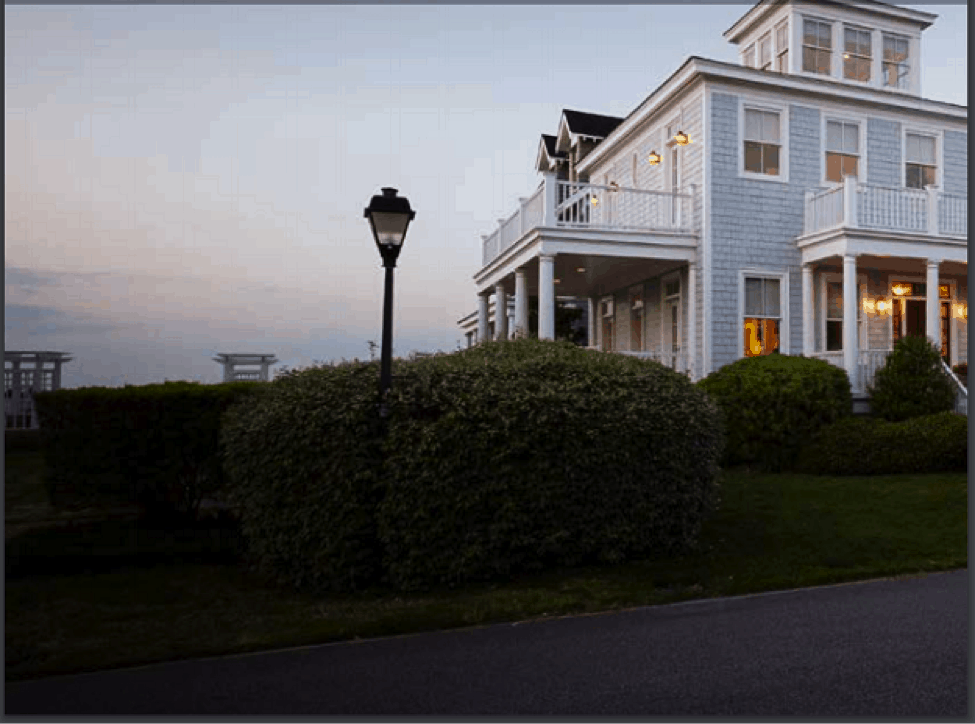Eco-Friendly Fiber Cement Siding
Keeping our planet sustainable has been and continues to be an important concern for homeowners, as well as builders. Using green products and materials helps preserve our natural resources and eliminate harmful Volatile Organic Compounds from the air.
It’s sometimes difficult to go green and still get optimal functionality and the aesthetic appeal that you’d like in designing your home. But as far as your home’s exterior, you’ll get both when you choose fiber cement siding.
Installing most types of siding on your home will help save energy costs, since it helps to insulate the home from the outside weather. There are pros and cons to every type of siding, whether it’s wood, vinyl, metal or fiber cement. But fiber cement siding is one of the most eco-friendly materials you can use for your home.
As Joseph Lstiburek, a forensic engineer who investigates building failures and is internationally recognized as an authority on moisture-related building problems and indoor air quality, states: “The single most important factor in green architecture is durability. If you want something to be green it has to last a long time. It has to handle water, heat and UV radiation. Fiber-cement handles all three exceptionally well.”
The most widely known brand and manufacturer of fiber cement siding is James Hardie. They are the premium makers of fiber cement siding and their products are found in over 8 million homes in North America.
Evidence of James Hardie’s Goals for Producing Green Products
The U.S. Green Building Council has created some guidelines for the building industry with the intent of achieving a healthier and more efficient environment. These guidelines are defined in the LEED program (Leadership in Energy and Environmental Design). LEED certification is a globally recognized symbol of sustainability achievement.
James Hardie products contribute points towards a LEED project certification as well as a certification to the ICC 700 National Green Building Standard. In order to earn this certification, companies must provide credible, third-party evident that their products meet all criteria that NGBS requires. A “MASTER” icon next to a listing indicates an individual has achieved exclusive, top-tier accreditation based on his/her significant green building knowledge and applied experience verifying NGBS Green compliance.
James Hardie siding, trim, soffit, fascia and Artisan siding and trim are listed as certified products in Home Innovation Research Labs NGBS Green Certified Product Program. This certification allows accredited verifiers to award points towards the whole project certification without additional documentation for the attributes of the practices specified.

James Hardie Fiber Cement Siding shares a common goal with other building manufacturers wanting to be more eco-friendly: to produce more efficient, healthier building products. However, there are several ways to measure the green factor, including what resources were used, how and where the product was made and durability.
Here are some features of James Hardie Fiber Cement Siding that make it a great choice for those wanting more environmentally-friendly products.
- James Hardie has high quality standards for the raw materials it uses.
- At least 75% of raw materials used are locally sourced. These materials are low in toxicity.
- Raw materials are extracted and processed near each manufacturing facility, which reduces the need to transport them.
- They operate 9 manufacturing facilities that support regional economy and also reduce the environmental impact caused by transportation of materials.
- Fiber cement materials are extremely durable, lasting much longer than other similar building materials. This saves on the cost and materials to repair, maintain and replace them.
- James Hardie’s unique ColorPlus Technology is produced by baking on the color in their factories. This eliminates VOCs from being transmitted in the air by exterior painting.
- James Hardie Siding is non-combustible.
- Their Zero to Landfill Project strives to make their products more efficient and is currently focused on reducing their landfilled waste by half.
- They recycle water used in manufacturing up to four times during the process.
- Their Artisan® siding products contain 8% post-industrial or pre-consumer recycled content.
Durability and Beauty of Fiber Cement Siding
As previously stated, durability and minimal maintenance are a key factor in preserving a sustainable environment. Most other siding materials may be more susceptible to fire, insects and wear and tear. The lifespan of siding made with wood, vinyl or metal tends to be around 15-20 years.

While that span may seem relatively long to you, it still means you will need to replace it, accumulating costs and adding waste products to the environment. A better option, both financially and environmentally, is to choose a product that lasts longer. Fiber Cement siding can last up to 50 years, a virtual lifetime for many. Maintenance is minimal, requiring a fresh coat of paint every 10 years or so. Fiber Cement siding is fireproof and not susceptible to rot or insect infestation.
Do you love the look of wood siding but don’t want the negative environmental effects of cutting down all those trees? You can get fiber cement siding that has the realistic and elegant look of wood grain in a variety of colors. You won’t have the high maintenance costs and labor that wood requires.
Fiber Cement Siding Beats Other Products in the Green Factor
Fiber cement siding is manufactured from recycled materials and other sustainable products. Cement, sand and cellulose are the main components. They are strong, but natural materials. Of course, while wood siding is certainly made from a natural product, the required number of trees needed have a very negative ecological effect on our environment.
Metal siding is made from recyclable materials, which is a positive aspect; however, it does not withstand the test of time. It degrades quickly, needing replacement a lot sooner than fiber cement siding. And you have to wonder if all the replaced metal siding is really being recycled.
Then there’s the vinyl siding, which is not made of natural materials. Neither is it recyclable or biodegradable. Vinyl siding can also emit volatile organic compounds (VOCs), which can contribute to environmental illnesses. Fiber cement does not emit such compounds.
Because vinyl can’t be repainted, it’s difficult to match when repairs are needed. That can result in the entire home being re-sided. And where does all the old vinyl siding end up? In the landfills, unfortunately.
Energy Efficiency
Insulating your home can decrease your heating and cooling bills. There are many methods to insulate your home and installing exterior siding is one great way. Including insulation behind the siding adds another layer of insulation and prevents drafts from getting into the gaps to help keep your utilities bills down.

Insulation can be added behind almost any type of exterior siding, but fiber cement siding is especially suited for this purpose. The insulation is made to be used specifically with the fiber cement siding, sealing it completely from drafts and gaps. This will keep the cold out in the winter and the heat out in the summer, making your home more comfortable, while reducing your utilities usage.
Even if you add insulation to vinyl siding, it won’t be completely sealed because of the nature of the vinyl siding molding. There will still be gaps in the exterior, allowing drafts to enter, so you won’t be saving as much energy as you may think.
James Hardie Fiber Cement Siding Recognized as Greenest Siding Brand
James Hardie is the leading manufacturer of fiber cement siding, trim and other related products. They were recognized as the “Greenest Siding Brand” in the Green Builder® Media annual Readers’ Choice survey for the sixth consecutive year. James Hardie was chosen over 10 other competitors for this award.
The Readers’ Choice survey products results of polling green building professionals in the residential construction industry. These professionals test products without bias, providing recommendations that can be used by other industry professionals.
James Hardie Fiber Cement Products Offer Many Benefits
James Hardie provides more than just great eco-friendly products. They offer a wide variety of styles and finishes. You can choose among virtually any color for your siding and other related products. And if you want to change that color in a few years, their siding can be easily repainted.
James Hardie has a siding line and trim that are engineered for any climate, called the HardieZone. No matter what climate you live in, you can get the right siding for the weather elements. With different types designed for each of eight different climate zones, you’ll know that your siding will withstand the temperatures, moisture and particular weather conditions for your area.

James Hardie offers a variety of styles that run from traditional lap design to shake, to vertical panels. You’re sure to find a style and design that meets your personal preferences.
And when it comes to colors, you’ll be surprised at the many factory choices you have. The finish is baked on, so it resists fading, chipping and scratching. The finish is so durable that James Hardie guarantees that you won’t have to repaint for at least 15 years, unless you want a different color.
By choosing James Hardie Fiber Cement siding, you can be sure of its quality and durability. With over 100 years of research, development and customer satisfaction behind it, you’ll join the millions of homeowners in enjoying its beauty.
Choose a James Hardie Elite Preferred Contractor
If you decide to go with the most eco-friendly, durable and beautiful James Hardie Fiber Cement siding, you want to hire one of their elite preferred contractors, like Banner Construction. We pride ourselves in maintaining these strict standards in quality and customer satisfaction.
Banner has provided outstanding customer service, quality products and installation and quality craftsmanship to the St. Louis metro area since 1993.
We prepare a comprehensive estimate, free of charge and answer all of your questions before we start.
Don’t wait to make your home the most beautiful one on the block, while keeping the environment green.
